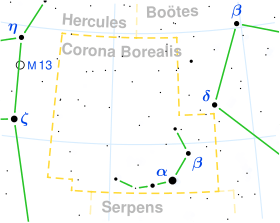Kappa Coronae Borealis
Kappa Coronae Borealis, Latinized from κ Coronae Borealis, is a star approximately 98 light years away in the constellation of Corona Borealis. The apparent magnitude is +4.82 (4.17 trillion times fainter than the Sun) and the absolute magnitude is +2.35 (9.82 times brighter than the Sun). It is an orange K-type subgiant star of spectral type K1IV, meaning it has nearly completely exhausted its hydrogen supply in its core. It is 1.32 times as massive as the Sun yet has brightened to 11.6 times its luminosity. Around 2.5 billion years old, it was formerly an A-type main sequence star.[6]
 | |
| Observation data Epoch J2000.0 Equinox J2000.0 | |
|---|---|
| Constellation | Corona Borealis |
| Right ascension | 15h 51m 13.9315s[1] |
| Declination | +35° 39′ 26.5647″[1] |
| Apparent magnitude (V) | +4.79[2] |
| Characteristics | |
| Spectral type | K0 III-IV[2] |
| Astrometry | |
| Proper motion (μ) | RA: −8.792±0.177[1] mas/yr Dec.: −347.766±0.202[1] mas/yr |
| Parallax (π) | 33.2328 ± 0.1083[1] mas |
| Distance | 98.1 ± 0.3 ly (30.09 ± 0.10 pc) |
| Absolute magnitude (MV) | +2.37[3] |
| Details[4] | |
| Mass | 1.32±0.10 M☉ |
| Radius | 4.77±0.07 R☉ |
| Luminosity | 11.6±0.3 L☉ |
| Surface gravity (log g) | 3.15±0.14 cgs |
| Temperature | 4,870±47 K |
| Metallicity [Fe/H] | +0.13±0.03 dex |
| Other designations | |
| Database references | |
| SIMBAD | data |
Dust disk
In March 2013, it was announced that resolved images of at least one dust disk surrounding Kappa Coronae Borealis were captured, making it the first subgiant to host such circumstellar belt.[6] The disk extends out to 120 AU.[7]
Planetary system
In October 2007, a giant planet was found by Johnson et al., who used the radial velocity method.[8] In 2012 it was confirmed.[2]
This planet was assumed to be outside the habitable zone on the assumption that the star is K1IVa.[9] Given the star's luminosity, the planet is more likely on the zone's inner edge.[10]
The width of the circumstellar belt suggests the presence of a second planetary companion of the star, either within it or between two narrower belts.[6]
| Companion (in order from star) |
Mass | Semimajor axis (AU) |
Orbital period (days) |
Eccentricity | Inclination | Radius |
|---|---|---|---|---|---|---|
| b | ≥1.811±0.057 MJ | 2.65±0.13 | 1285±14 | 0.167±0.032 | — | — |
See also
- HD 16175
- HD 167042
- List of extrasolar planets
- Rho Coronae Borealis
References
- Brown, A. G. A.; et al. (Gaia collaboration) (August 2018). "Gaia Data Release 2: Summary of the contents and survey properties". Astronomy & Astrophysics. 616. A1. arXiv:1804.09365. Bibcode:2018A&A...616A...1G. doi:10.1051/0004-6361/201833051. Gaia DR2 record for this source at VizieR.
- Sato, Bun'ei; et al. (2012). "Substellar Companions to Seven Evolved Intermediate-Mass Stars". Publications of the Astronomical Society of Japan. 64 (6). 135. arXiv:1207.3141. Bibcode:2012PASJ...64..135S. doi:10.1093/pasj/64.6.135.
- Anderson, E.; Francis, Ch. (2012), "XHIP: An extended hipparcos compilation", Astronomy Letters, 38 (5): 331, arXiv:1108.4971, Bibcode:2012AstL...38..331A, doi:10.1134/S1063773712050015.
- White, T. R.; et al. (July 2018). "Interferometric diameters of five evolved intermediate-mass planet-hosting stars measured with PAVO at the CHARA Array". Monthly Notices of the Royal Astronomical Society. 477 (4): 4403–4413. arXiv:1804.05976. Bibcode:2018MNRAS.477.4403W. doi:10.1093/mnras/sty898.
- "Kappa Coronae Borealis". SIMBAD. Centre de données astronomiques de Strasbourg. Retrieved 2019-09-21.
- Bonsor, Amy; et al. (2013). "Spatially resolved images of dust belt(s) around the planet-hosting subgiant κ CrB". MNRAS. 431 (4): 3025–3035. arXiv:1302.7000. Bibcode:2013MNRAS.431.3025B. doi:10.1093/mnras/stt367.
- Pawellek, Nicole; Krivov, Alexander V.; Marshall, Jonathan P.; Montesinos, Benjamin; Ábrahám, Péter; Moór, Attila; Bryden, Geoffrey; Eiroa, Carlos (2014). "Disk Radii and Grain Sizes in Herschel-resolved Debris Disks". The Astrophysical Journal. 792 (1): 19. arXiv:1407.4579. Bibcode:2014ApJ...792...65P. doi:10.1088/0004-637X/792/1/65. 65.
- Johnson, John Asher; et al. (2008). "Retired A Stars and Their Companions. II. Jovian Planets Orbiting κ CrB and HD 167042". The Astrophysical Journal. 675 (1): 784–789. arXiv:0711.4367. Bibcode:2008ApJ...675..784J. doi:10.1086/526453.
- "Planet kappa CrB b". Archived from the original on 2013-02-11.
- An earth-analogue should be slightly more than 3 AU away: square root of luminosity 12.9.
- Luhn, Jacob K.; et al. (2019). "Retired A Stars and Their Companions. VIII. 15 New Planetary Signals around Subgiants and Transit Parameters for California Planet Search Planets with Subgiant Hosts". The Astronomical Journal. 157 (4). 149. arXiv:1811.03043. Bibcode:2019AJ....157..149L. doi:10.3847/1538-3881/aaf5d0.